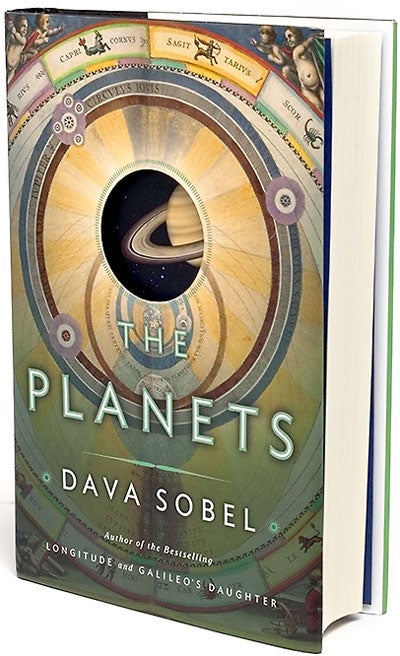Dava Sobel, 288 pages; Viking Adult, 2005; hardcover, $24.95
I’ve tasted Moon dust like Dava Sobel’s friend as told in this new book. I can’t say it transformed me in any way, but the offer was too good to refuse. Like the temptation of Moon dust, Sobel’s The Planets is just too good for anyone who loves the sky to pass on.
Dava Sobel is best known as the author of Longitude, published in 1994, which tells the story of John Harrison and his struggle to solve the problem of determining longitude at sea. Dava Sobel admits she is not a scientist, yet, she told the story of Harrison so compellingly that she almost single-handedly created the “scientific micro-history” genre — examples of which now fill bookstore shelves.
The Planets, however, is anything but a micro-history. This book is a look at a subject that has intrigued Sobel since her youth. She takes the reader on a cultural tour of our solar system that is less science than sentiment. In traditional fashion, Sobel starts with our central orb, the Sun, and makes her way to the edge of what we know about our cosmic backyard. The titles of each chapter are a dead giveaway that this is not your usual astronomy book. Genesis, Mythology, Lunacy, Astrology, and Night Air are a few headings that promise to take the reader on an unconventional tour of the planets.
Sobel also uses an interesting technique for each chapter. Rather than simply telling us about each planet in turn, she lets each chapter speak in a unique voice. The most effective use of this technique, and my favorite chapter, is Night Air, which is cast as an imagined letter from Caroline Herschel to American astronomer Maria Mitchell. The tone of the “letter” is almost lyrical and provides a feel for what women who aspired to astronomy in the 19th century had to overcome. At the same time, Sobel weaves into this “letter” the discovery of Uranus and Neptune.
| Death Rays, Jet Packs, Stunts, and Supercars: The Fantastic Physics of Film’s Most Celebrated Secret Agent |
| Barry Parker, 248 pages; Johns Hopkins University Press, 2005; hardcover, $25 |
 Barry Parker, a physicist at Idaho State University, explores the physics in many James Bond movies: the stunts, gadgets, and, of course, cars. Parker begins with an overview of the 20 Bond movies, for those who need to brush up on the movies’ plots. He then jumps into explanations of many basic physics concepts — Newton’s laws of motion, potential and kinetic energy, and planetary mechanics — and a slew of more specific examples — ballistics, bungee jumping, hovercrafts, and nuclear reactors. He incorporates simple math equations — no calculus needed — into his explanations. — Liz Kruesi Barry Parker, a physicist at Idaho State University, explores the physics in many James Bond movies: the stunts, gadgets, and, of course, cars. Parker begins with an overview of the 20 Bond movies, for those who need to brush up on the movies’ plots. He then jumps into explanations of many basic physics concepts — Newton’s laws of motion, potential and kinetic energy, and planetary mechanics — and a slew of more specific examples — ballistics, bungee jumping, hovercrafts, and nuclear reactors. He incorporates simple math equations — no calculus needed — into his explanations. — Liz Kruesi |
In the story of Saturn and how its mysteries were slowly revealed, Sobel introduces us to Gustav Holst and his musical composition The Planets, Suite for Orchestra. She then carries the musical thread through the rest of the chapter. It’s as if she is letting the music of the spheres intone the magic of the ringed planet.
The chapter in which this use of “voices” seems the weakest is SCI-FI, which gives the history of Mars from the viewpoint of the martian meteorite Allan Hills 84001. It’s a bit of a stretch to keep the meteorite “talking,” yet the chapter works. Also, the chapter Genesis is almost tedious in the attempt to intertwine the biblical story of creation with the modern view of solar system formation. Sobel’s explanation of tides in her lunar story is a bit muddled as well. These small shortcomings are quickly forgotten, and forgiven, with her autobiographical narrative of family history in the chapter called UFO — Pluto — and what it means to be “alien” in a strange world.
Dava Sobel gives no quarter to those who might be short on literary breadth and depth. She freely quotes from poets, philosophers, and literature throughout The Planets. Sobel also assumes some familiarity with the history of science that may challenge some to remember stories about Urbain Jean-Joseph Leverrier and John Couch Adams, or who Johann Gottfried Galle and Johann Franz Encke were. There are numerous footnotes throughout the book to help the reader.
The best part of Sobel’s book is the opening. This section is true autobiography, as Sobel takes us back to her experiences in third grade and her sheer joy in making a diorama of the solar system, “with a complete lack of artistic skill,” something strictly forbidden in today’s high-tech science fairs. This small story of learning about the planets should remind all of those who profess to teach astronomy that the simplest methods are often the best.
Sobel’s book is also a firm reminder that we should not lose sight of the fact that astronomy and science as a whole are an amalgam of human experience. There is no true appreciation of Mars without Edgar Rice Burroughs, no fascination of Saturn without Gustav Holst, and no love of Venus without William Blake or Robert Frost. Like the diorama in a shoebox, The Planets captures the solar system in miniature for us to marvel at and enjoy.
— Raymond Shubinski, a frequent Astronomy contributor, is the director of the East Kentucky Science Center.










